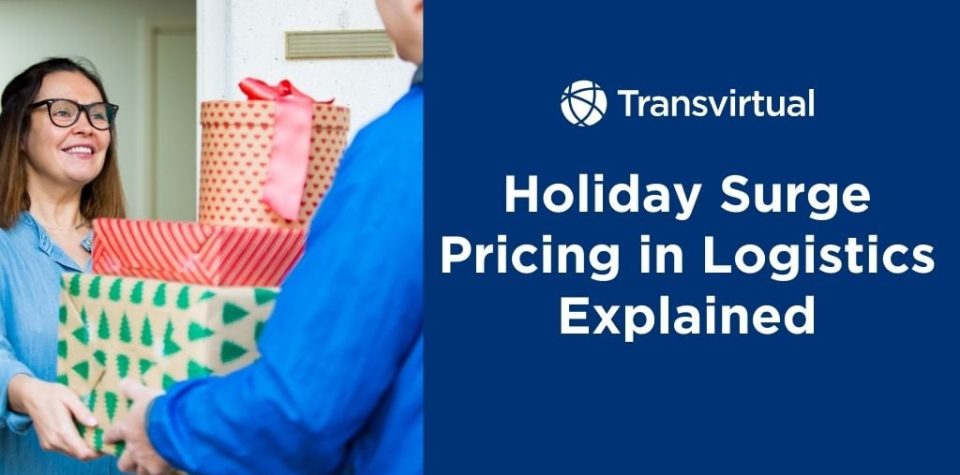Table of Contents
The holidays always bring a series of interesting challenges for businesses in transportation and logistics. The most festive months of the year see skyrocketing demand, stretched resources, and a range of other complications for maintaining reliable services, including those provided by the postal service. That’s why many logistics providers turn to a strategy called surge pricing as a solution to their issues.
Surge pricing involved dynamic price adjustments to reflect seasonal demand fluctuations. Implementing this strategy during the holidays requires a lot of careful planning and open communication coupled with a balancing act between maintaining customer relationships and maximising profits.
Understanding Holiday Surge Pricing and Surcharges
There’s a lot more to holiday surge pricing than simply capitalising on increased demand. You need to make sure your logistics operations are ready to deliver effectively during any time of the year, but especially during the busiest periods.
During the busiest periods, utilizing services at the post office or your courier partner efficiently can help manage the increased demand and ensure timely deliveries.
Your goal should be to balance supply and demand while encouraging your customers to make decisions that alleviate pressure on your limited resources. This might mean higher profitability overall, but it comes with the added challenge of maintaining customer goodwill during a seriously sensitive time.
Understanding Shipping Surcharges
Shipping surcharges are additional fees that shipping carriers impose to cover various costs, such as fuel price fluctuations, transportation expenses, and other operational costs. These surcharges can significantly increase the overall cost of shipping, both domestically and internationally. For instance, carriers like UPS and FedEx often apply fuel surcharges, oversized package surcharges, and temporary surcharges during peak shopping seasons.
Understanding these surcharges is crucial for businesses to manage their shipping costs effectively. Many shipping contracts with freight companies include complex expenses that can impact potential charges, lead times, and pickup locations. Unfortunately, a lack of knowledge about these surcharges and the fine print can lead businesses to pay significantly more than necessary on package overhead. By staying informed and carefully reviewing shipping contracts, businesses can better anticipate and manage these additional costs.
Causes of Holiday Shipping Increases
The holiday season is synonymous with a surge in shipping demand, leading carriers to increase their rates. Several factors contribute to these holiday shipping increases:
Increased Fuel Costs: Carriers need to pay more for fuel to transport the higher volume of packages, and these costs are passed on to customers as surcharges.
Higher Labor Costs: To handle the increased volume of packages, carriers often hire additional staff, which raises their labor costs.
Increased Demand: The holiday season sees a significant spike in online shopping, resulting in more packages that need to be delivered, thereby increasing costs for carriers.
Fewer Days: With fewer days between Thanksgiving and Christmas, carriers have less time to deliver packages, which can lead to increased costs and surcharges to ensure timely delivery.
Understanding these factors can help businesses plan better and anticipate the additional costs associated with holiday shipping.
Strategies for Implementing Holiday Surge Pricing and Managing Shipping Costs
Data-Driven Demand Analysis: Before you make any major decisions, it’s important to understand all your data. If you analyse historical demand data and utilise predictive analytics to identify peak holiday periods, you’ll gain some serious benefits each holiday season.
Real-Time Monitoring: Take advantage of modern systems that enable real-time capacity and demand tracking. The more accurate your visibility, the more precisely you can time surge pricing adjustments. That means you won’t have to solely rely on educated guesswork.
Tiered Pricing for Holiday Peaks: The holiday season routinely shows demand spiking in varying intensity. A tiered surge pricing approach allows your business to make pricing feel more flexible. You can use different surge tiers based on the intensity of demand to help your customers anticipate cost increases and feel more in control, especially when using services like Parcel Post.
Limited Time Windows: If you want to avoid customer dissatisfaction, keep your surge pricing windows predictable and brief. Customers are typically more understanding during holidays if surges apply only during peak shopping days – Black Friday or the week before Christmas – rather than throughout the season.
Communicating Price Changes and Delivery Updates to Customers
Very few things undermine customer trust as quickly and severely as a surprise price increase – especially during the holidays when budgets might be tighter. Make sure you’re always clear about the timing and the reasons for surge pricing. Be transparent about any shipping surcharge that may apply during peak periods to help customers understand the reasons behind the price increases. As long as you aren’t catching your customers off-guard about upcoming high-demand periods that require price increases, they’ll be far more understanding.
There are quite a few ways you can achieve this clear and open communication. Most businesses use emails, SMS notifications, and app alerts to inform their customers. This type of multi-channel communication is the best way to ensure no one misses any vital information and mitigates any frustration surge pricing could cause.
When you make it known that your prices will increase to combat demand, focus on the idea that increasing those prices is a good thing for both your business and your customers. You’ll be able to reduce delays and keep your customer service offerings at optimal performance even during the craziest days of the holiday season.
And if you really want to keep your customers happy, provide them with some extra options. Off-peak scheduling discounts and flexibility incentives might allow them to manage their costs more effectively and they’ll still be able to expect their shipment deliveries on time.
Carrier Deadlines and Cut-Offs
Meeting carrier deadlines and cut-offs is essential for ensuring timely delivery of packages during the holiday season. Here are some key deadlines to keep in mind:
USPS Shipping Date Deadlines: The USPS website provides specific deadlines for different services, such as Priority Mail and Priority Mail Express. Checking these deadlines can help you plan your shipments effectively.
FedEx Holiday Shipping Deadlines: FedEx offers various services with different deadlines, such as FedEx Ground and FedEx Express. Knowing these deadlines can help you choose the right service for your needs.
UPS Peak Season Surcharges: UPS implements higher peak season surcharges for packages shipped between November 24 and December 28. Being aware of these surcharges can help you budget for the increased costs.
By adhering to these deadlines, businesses can ensure their packages are delivered on time, avoiding delays and additional surcharges.
Peak Season Shipping Considerations
Shipping during peak seasons requires careful planning to ensure timely and cost-effective delivery. Here are some key considerations:
Plan Ahead: Book your shipping in advance to avoid last-minute fees and surcharges. Early planning can help you secure better rates and ensure timely delivery.
Choose the Right Carrier: Select a carrier that offers the best rates and services for your business needs. Comparing different carriers can help you find the most cost-effective option.
Optimize Packaging: Use the right packaging materials and sizes to minimize costs and reduce the risk of damage. Proper packaging can also help you avoid additional handling fees.
Monitor Weather Conditions: Inclement weather can cause delays and disruptions. Monitoring weather conditions and planning accordingly can help you avoid unexpected delays.
By considering these factors, businesses can better manage their shipping operations during peak seasons, ensuring timely and cost-effective delivery.
Optimizing Logistics for Peak Seasons
Optimizing logistics for peak seasons requires a strategic approach to ensure timely and cost-effective delivery. Here are some key strategies:
Implement a Flexible Shipping Strategy: Offer flexible shipping options, such as free shipping or expedited shipping, to attract customers and reduce cart abandonment rates. Flexibility can also help you manage demand more effectively.
Use Data Analytics: Analyze data on shipping patterns and customer behavior to optimize logistics and reduce costs. Data-driven insights can help you make informed decisions and improve efficiency.
Invest in Automation: Automate shipping processes, such as labeling and tracking, to reduce manual errors and increase efficiency. Automation can also help you handle higher volumes more effectively.
Partner with Carriers: Build relationships with carriers to negotiate better rates and services. Strong partnerships can help you secure more favorable terms and improve your overall shipping operations.
By implementing these strategies, businesses can optimize their logistics during peak seasons, ensuring timely and cost-effective delivery of packages.
Balancing Profit with Customer Relationships and Managing Fees During the Holidays
Off-Peak Use Incentives: As we just mentioned, you can encourage your regular customers to shift their demands away from the busiest days of the year by offering incentives for off-peak periods. Doing this helps you balance demand and still provide your loyal customers with affordable options. This way, you can maintain your lasting relationships regardless of surge pricing.
Customer Segmentation: Think carefully about the different types of customers you serve. Your long-term clients might reasonably expect, and potentially deserve, a level of leniency during holidays. You might provide them with discounts and exemptions to surge pricing as a token of appreciation for their ongoing loyalty. This can help strengthen those relationships to ensure they last.
Feedback Mechanisms: Create a few open channels for feedback at the end of the holiday surge period. Your customers will appreciate opportunities to voice their opinions on your services and you’ll gain some great insights into how your strategies were received. Then, you can use this feedback to refine your future holiday surge pricing logistics strategies.
Be consistent: Be sure to consistently apply your holiday surge pricing policies. The last thing you want is a negative reaction from customers when they notice inconsistencies. Remember: emotions tend to be heightened during the holiday months. With clear guidelines, you’ll maintain their trust and enable more comfortable conversations about your price changes.
The Balancing Act
For most businesses, the holiday months are full of profit potential. But it’s far too often the case that they sacrifice customer relationships to capture as much profit as possible from the exceptionally high demand of the season. That’s why you need to take customer perspectives carefully into account and apply data-driven strategies supported by clear communication.
As long as you can ensure your customers feel your service is fair and reliable year-round, you’ll be able to put logistics surge pricing strategies into effect without headache.
Ready to optimize your holiday logistics? Partner with Transvirtual today. Schedule a free consultation with our logistics specialists today.



